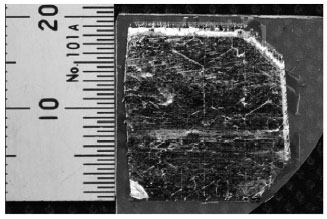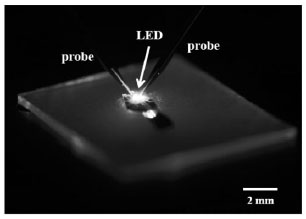Materials Science Laboratory
Nitride semiconductors are the materials of choice for a variety of device
applications. One important practical goal is to realize such devices on
large, flexible and affordable substrates, on which direct growth of nitride
semiconductors of sufficient quality is problematic. Several techniques
have been investigated to enable the transfer of nitride devices from one
substrate to another, but existing methods still have some important disadvantage.
Here we demonstrate that hexagonal boron nitride (h-BN) can form a release
layer that enables the mechanical transfer of GaN-based device structures
onto foreign substrates [1].
Photograph in Figure 1 shows the transferred AlGaN/GaN heterostructure,
approximately 2 cm square, on an adhesive sheet (an indium sheet in this
case) attached to a foreign sapphire substrate. We can see the surface
of the indium sheet because the AlGaN is transparent. The size of the transferred
area can be controlled by the adhesive sheet size. Some protrusions from
the indium sheet are clearly visible, indicating the AlGaN/GaN heterostructure
is mechanically released from the native sapphire substrate. No cracks
were observed in the transparent AlGaN/GaN heterostructure up to maximum
size of about 1 cm square, suggesting that mechanical release process using
the h-BN layer ensures minimal crack formation. Next, we describe the electroluminescence
emitted from the transferred multiple quantum well (MQW) light-emitting
diode (LED) at room temperature. For comparison, the same MQW LED structure
was grown on a typical low-temperature AlN buffer layer on a sapphire substrate
and the conventional MQW LED was fabricated without lift-off. Current-voltage
characteristics of the transferred LED show clear rectification. The electroluminescence
intensities from the transferred LED were comparable to or higher than
the intensities from the conventional LED on the low-temperature AlN buffer
layer at the same current. The comparable intensities of the electroluminescence
of the conventional and transferred LED indicate that the MQW preserves
its original quality after the transfer. We further succeeded in transferring
a verticaltype LED. This vertical-type LED emits blue light at room temperature
(Figure 2).
The process we report here opens the way to releasing and transferring
a wide range of nitride semiconductor devices to large-area, flexible and
affordable substrates.
[1] Y. Kobayashi, K. Kumakura, T. Akasaka, and T. Makimoto, Nature 484 (2012) 223.
 |
 |
|||||
|
|